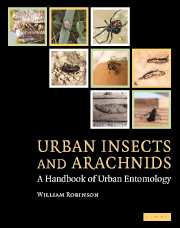Book contents
- Frontmatter
- Contents
- Preface
- Part I Urban entomology
- Part II Insects in the urban environment
- 4 Blattaria
- 5 Coleoptera
- 6 Collembola, Dermaptera
- 7 Diptera, Ephemeroptera
- 8 Hemiptera, Homoptera
- 9 Hymenoptera
- 10 Isoptera
- 11 Lepidoptera
- 12 Mantodea, Neuroptera
- 13 Orthoptera, Phasmatodea
- 14 Phthiraptera
- 15 Plecoptera, Psocoptera
- 16 Siphonaptera
- 17 Thysanoptera, Thysanura, Trichoptera
- Part III Other arthropods in the urban environment
- Family, genus, species index
- Index
- References
14 - Phthiraptera
Published online by Cambridge University Press: 06 August 2009
- Frontmatter
- Contents
- Preface
- Part I Urban entomology
- Part II Insects in the urban environment
- 4 Blattaria
- 5 Coleoptera
- 6 Collembola, Dermaptera
- 7 Diptera, Ephemeroptera
- 8 Hemiptera, Homoptera
- 9 Hymenoptera
- 10 Isoptera
- 11 Lepidoptera
- 12 Mantodea, Neuroptera
- 13 Orthoptera, Phasmatodea
- 14 Phthiraptera
- 15 Plecoptera, Psocoptera
- 16 Siphonaptera
- 17 Thysanoptera, Thysanura, Trichoptera
- Part III Other arthropods in the urban environment
- Family, genus, species index
- Index
- References
Summary
Introduction
Classification of the sucking and chewing lice has followed several schemes. Some place these insects in two orders: Anoplura, the sucking lice, and Mallophaga, the chewing lice. This classification considers the differences in the morphology and habits of the lice, and has a history of use and acceptance. Other entomologists recognize a single order, Phthiraptera, with four suborders: Amblycera, Ischnocera, Anoplura, and Rhynchophthirina. Lice in the suborders Amblycera and Ischnocera (both previously the Mallophaga) have biting mouthparts and are associated with birds and mammals. Anoplura and Rhynchophthirina have only placental mammals as hosts and possess sucking (anoplurans) and biting mouthparts. Classification using the single order of lice, Phthiraptera, has the utility of bringing together this monophyletic group of insects, without reducing the differences in morphology and habits.
Phthiraptera are wingless insects that are ectoparasites on mammals or birds, and spend all of their lives in the skin, fur, hair, or feathers of their host. They evolved from psocopteran-like ancestors that lived in the nests of mammals and birds, and in that habitat fed on the shed skin of the host and other detritus with biting–chewing mouthparts. Close association with animals at their nest site probably led to intimate and permanent association with the animal itself, and the development of blood-feeding mouthparts.
Suborder: Amblycera (= Mallophaga)
These are the chewing lice. Adults are 1–6 mm long. They are somewhat flattened, brown to pale brown, and wingless.
- Type
- Chapter
- Information
- Urban Insects and ArachnidsA Handbook of Urban Entomology, pp. 359 - 364Publisher: Cambridge University PressPrint publication year: 2005



